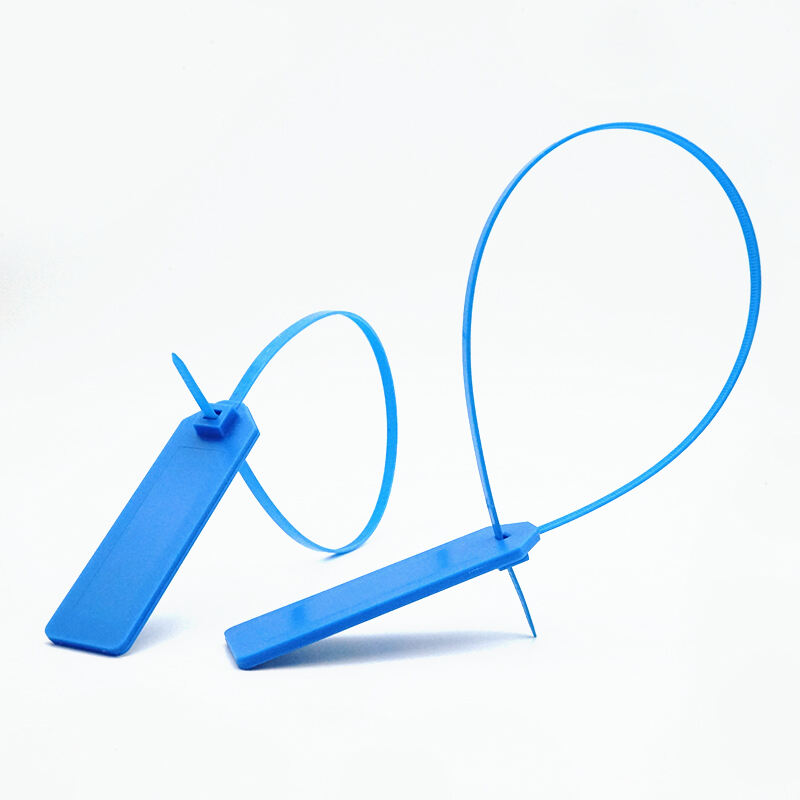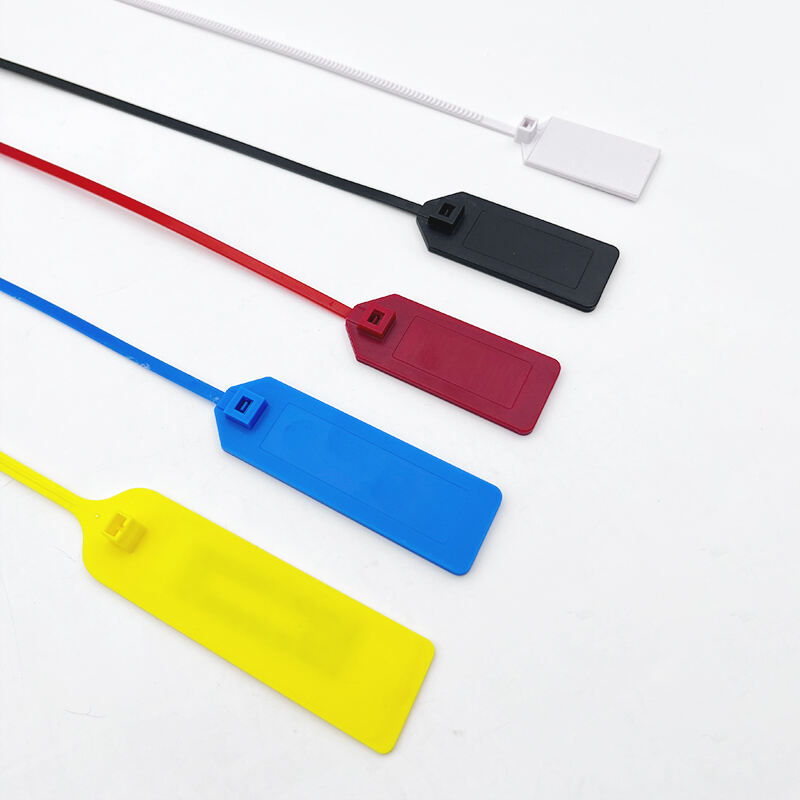แท็กสายรัดแบบ RFID เป็นอุปกรณ์ยึดติดพิเศษที่ติดตั้งชิปและเสาอากาศ RFID ไว้ภายใน ช่วยให้สามารถสื่อสารแบบไร้สายเพื่อการระบุตัวตนและการติดตาม โดยทั่วไปทำจากพลาสติกที่มีความทนทาน เช่น ABS (อะคริโลไนตริล บิวตาไดอีน สไตรีน) หรือ PP (พอลิโพรพิลีน) แท็กเหล่านี้ทำหน้าที่เป็นสายรัดที่มีความปลอดภัยและสามารถตรวจสอบการเปิดหรือแก้ไขได้ ในขณะที่ส่งข้อมูลผ่านคลื่นวิทยุ ชิปจะเก็บข้อมูลรหัสประจำตัวที่ไม่ซ้ำกัน (เช่น รหัส EPC) ซึ่งช่วยให้เครื่องอ่านสามารถเข้าถึงข้อมูลได้โดยไม่ต้องมีการมองเห็นโดยตรง จากระยะทางตั้งแต่ไม่กี่เซนติเมตรไปจนถึงหลายเมตร ขึ้นอยู่กับความถี่ (เช่น HF หรือ UHF)
ต่างจากบาร์โค้ดแบบธรรมดาที่ต้องสแกนด้วยมือและมักชำรุดเสียหายได้ง่าย สายรัดแบบ RFID สามารถอ่านข้อมูลได้แบบไม่สัมผัสและอ่านเป็นกลุ่ม—สแกนได้สูงสุดหลายร้อยแท็กพร้อมกัน ทำให้เหมาะสำหรับใช้ในสภาพแวดล้อมที่ยากลำบาก ทนต่ออุณหภูมิระหว่าง -40°C ถึง +85°C ความชื้น และแรงกระแทกทางกล รุ่นขั้นสูงมีการออกแบบป้องกันการแก้ไข ทำให้แท็กใช้งานไม่ได้หากถูกถอดออก เพื่อป้องกันการนำกลับมาใช้ใหม่หรือการขโมยโดยไม่ได้รับอนุญาต
สายรัด RFID โดยทั่วไปแบ่งออกเป็นสองประเภท คือแบบใช้ครั้งเดียวและแบบใช้ซ้ำได้ แต่ละแบบถูกออกแบบให้เหมาะกับความทนทานและต้นทุนที่ต้องการ
เหล่านี้เป็นสายรัดที่มีน้ำหนักเบาและคุ้มค่า ทำจากไนลอนสำหรับใช้เพียงครั้งเดียว คุณสมบัติหลัก ได้แก่ ความแข็งแรงทนทานสูง ทนต่อรังสี UV และสารเคมี และมีกลไกการล็อกอัตโนมัติที่ช่วยให้เกิดความปลอดภัย สายรัดเหล่านี้สามารถตรวจสอบการเปิดหรือแก้ไขได้ เนื่องจากจะแตกหักหรือเสียการใช้งานเมื่อถอดออก อย่างไรก็ตาม มีข้อจำกัดด้านอุณหภูมิ (ใช้งานได้สูงสุดที่ 80°C) และอาจแตกเปราะในสภาพอากาศเย็นจัดที่ต่ำกว่า 10°C ซึ่งจำเป็นต้องใช้รุ่นที่ทนความเย็นเป็นพิเศษสำหรับการใช้งานในอุณหภูมิติดลบ เช่น โลจิสติกส์กลางแจ้งในฤดูหนาว

ผลิตจากพอลิโพรพิลีนที่เป็นมิตรต่อสิ่งแวดล้อม ป้ายเหล่านี้เน้นเรื่องความยั่งยืน และเหมาะสำหรับการใช้งานที่ต้องการความละเอียดอ่อน เช่น การติดตามอาหาร คุณสมบัติรวมถึงกันน้ำพื้นฐาน ความทนทานแข็งแรง และดีไซน์ที่ไม่สามารถถอดออกได้เพื่อป้องกันการใช้งานซ้ำ มีความต้านทานต่อสารเคมีที่ดี แต่มีแรงดึงต่ำกว่าไนลอน เหมาะสำหรับสภาพแวดล้อมที่ต้องการความสะอาด เช่น การแปรรูปเนื้อสัตว์ หรือโลจิสติกส์ทางเภสัชกรรม
รุ่นนี้เพิ่มประสิทธิภาพของสายรัด PP มาตรฐาน โดยเพิ่มหัวเข็มขัดโลหะที่ช่วยเพิ่มความต้านทานการดึง เพื่อให้เหมาะสมกับการใช้งานที่หนักหน่วง หัวล็อคโลหะยังช่วยเพิ่มความปลอดภัยจากการแก้ไขโดยไม่ได้รับอนุญาต ในขณะที่ตัวสายรัดทำจากวัสดุ PP ช่วยให้มีความยืดหยุ่นและทนต่อการกัดกร่อน ผลิตภัณฑ์นี้ได้รับความนิยมในงานที่ใช้งานหนัก แม้ว่าชิ้นส่วนโลหะอาจเพิ่มต้นทุน และต้องตรวจสอบความเข้ากันได้ในสภาพแวดล้อม RFID ที่ไวต่อโลหะ
สายรัดแบบใช้ซ้ำได้ ประกอบด้วยหัวทำจากวัสดุ ABS และสายรัดทำจากไนลอน มีกลไก snap-lock ที่สามารถเปิด-ปิดได้โดยไม่ต้องใช้เครื่องมือ โดดเด่นด้วยคุณสมบัติการกันไฟฟ้าได้ดี ทนต่อการเสื่อมสภาพตามอายุการใช้งาน และมีแรงดึงสูง ช่วยลดต้นทุนระยะยาวด้วยการใช้งานซ้ำได้หลายครั้ง 
แท็กสายรัด RFID ใช้เทคโนโลยีหลักหลายอย่างเพื่อให้แน่ใจถึงความเชื่อถือได้:
ช่วงความถี่: ความถี่สูง (HF, 13.56 MHz) สำหรับการโต้ตอบผ่าน NFC; และความถี่อัลตราไฮ (UHF, 860-960 MHz) สำหรับการอ่านระยะไกล (สูงสุด 10 เมตร) แบบจำนวนมาก ซึ่งเป็นไปตามมาตรฐาน ISO/IEC 18000-63 Type C
การออกแบบชิปและแอนเทนา: ชิปอย่างเช่นซีรีส์ UCODE ของ NXP ให้ความจำสูง (สูงสุด 128 บิต EPC) และโปรโตคอลป้องกันการชนกันสำหรับการอ่านพร้อมกัน แอนเทนาส่วนใหญ่ทำด้วยวิธีการกัดกร่อนหรือพิมพ์เพื่อความยืดหยุ่น โดยรุ่นที่ต้านทานโลหะใช้การป้องกันด้วยเฟอร์ไรต์เพื่อลดสัญญาณรบกวนบนพื้นผิวโลหะ
คุณสมบัติด้านความปลอดภัย: การเข้ารหัส (เช่น AES-128) และรหัสประจำตัวที่ไม่ซ้ำกันช่วยป้องกันการเลียนแบบ ในขณะที่กลไกป้องกันการแก้ไขจะกระตุ้นการแจ้งเตือนหรือปิดการใช้งานแท็กเมื่อเกิดการละเมิด
การผสานรวมกับ IoT: แท็ก RFID มีแนวโน้มรวมเซ็นเซอร์สำหรับการตรวจสอบสภาพแวดล้อม (เช่น อุณหภูมิ ความชื้น) เพื่อให้สามารถบำรุงรักษาเชิงพยากรณ์และการปฏิบัติตามข้อกำหนด
การเลือกวัสดุมีความสำคัญต่อประสิทธิภาพและการปฏิบัติตามข้อกำหนด:
ABS: มีความต้านทานการกระแทกและทนความร้อนได้ดี (สูงถึง 65°C สำหรับหัวตัด) เหมาะสำหรับแท็กที่ใช้ซ้ำได้ในสภาพแวดล้อมอุตสาหกรรม
PP: มีน้ำหนักเบา รีไซเคิลได้ และทนสารเคมีได้ดี เหมาะสำหรับการใช้งานแบบทิ้งเพื่อสิ่งแวดล้อม แม้จะมีความแข็งแรงลดลงเมื่ออยู่ในอุณหภูมิสุดขั้ว
ไนลอน: มีความแข็งแรงทนทานและความยืดหยุ่นสูง แต่จำเป็นต้องใช้สารเติมแต่งเพื่อเพิ่มความต้านทานรังสี UV และความเย็น (เช่น ต่ำถึง -20°C ซึ่งมีค่าใช้จ่ายเพิ่มขึ้น)
วัสดุคอมโพสิตขั้นสูง: วัสดุใหม่ๆ เช่น โพลิเมอร์ที่ย่อยสลายได้ ช่วยลดผลกระทบต่อสิ่งแวดล้อม พร้อมคงความทนทานไว้ได้

แท็กสายรัด RFID โดดเด่นในหลากหลายอุตสาหกรรมด้วยความหลากหลายในการใช้งาน
แท็ก RFID ใช้ในการรักษาความปลอดภัยและการติดตามพาเลทหรือการจัดส่ง ช่วยให้เห็นข้อมูลแบบเรียลไทม์ ในอุตสาหกรรมขนส่ง แท็กช่วยในการเช็คอินอัตโนมัติ เพิ่มความโปร่งใสในห่วงโซ่อุปทานระดับโลก
ใช้สำหรับติดแท็กอุปกรณ์หรือสินค้าคงคลังภายในคลังสินค้า ช่วยให้ตรวจสอบสินค้าได้อย่างรวดเร็วและป้องกันการสูญเสีย
บนสายการผลิต แท็กจะติดตามเครื่องมือและชิ้นส่วนต่าง ๆ ช่วยเพิ่มประสิทธิภาพการผลิตแบบอัตโนมัติ เช่น ปรับปรุงการจัดการเครื่องมือและระบบติดตามชิ้นส่วนในโรงงาน
แท็ก RFID ใช้จัดการอุปกรณ์ทางการแพทย์ สายรัดข้อมือผู้ป่วย (ในรูปแบบที่ปรับปรุงแล้ว) และเวชภัณฑ์ ช่วยเพิ่มประสิทธิภาพและลดข้อผิดพลาดในโรงพยาบาล
ในร้านค้า แท็กช่วยป้องกันการขโมยสินค้าผ่านการบูรณาการระบบ EAS (Electronic Article Surveillance) และทำให้ขั้นตอนชำระเงินรวดเร็วขึ้น ส่งเสริมประสบการณ์ลูกค้าในธุรกิจค้าปลีกที่มีปริมาณสูง
การติดตั้งประกอบด้วย:
การประเมิน: ประเมินความต้องการ (เช่น ระยะการอ่าน สภาพแวดล้อม) และเลือกประเภท (แบบใช้ครั้งเดียวสำหรับงานเฉพาะ หรือแบบใช้ซ้ำเพื่อประหยัดค่าใช้จ่าย)
การผสานรวม: ติดตั้งแท็กกับทรัพย์สิน โปรแกรมชิปด้วยข้อมูล และติดตั้งเครื่องอ่าน (แบบพกพาหรือเกตเวย์แบบติดตั้งถาวร)
การตั้งค่าซอฟต์แวร์: เชื่อมต่อกับแพลตฟอร์ม ERP หรือ IoT เพื่อวิเคราะห์ข้อมูล โดยตรวจสอบให้แน่ใจว่ามีความเข้ากันได้กับมาตรฐานต่าง ๆ
การทดสอบและการขยายระบบ: ทดลองใช้ในพื้นที่เล็ก ๆ ก่อน จากนั้นค่อยขยายพื้นที่ โดยตรวจสอบการรบกวน (เช่น พื้นผิวโลหะจำเป็นต้องใช้แท็กต้านโลหะ)